峨眉山大火成岩省位于我国扬子克拉通西部以及越南北部,其成因与二叠纪晚期的地幔柱作用有关(Chung and Jahn, 1995;Xu et al., 2001;Xiao et al., 2004)。区域内赋存有攀枝花、红格、白马、太和和新街等数个大型-超大型Fe-Ti-V氧化物矿床和力马河、金宝山、白马寨、朱布等Cu-Ni-(PGE)硫化物矿床(Xu et al., 2001;宋谢炎等,2018)。由于矿床成矿条件具有专属性,Fe-Ti-V氧化物矿床通常形成于相对氧化的环境中,而Cu-Ni-(PGE)硫化物矿床形成于相对还原的环境。地幔柱岩浆体系起源于地幔深部较还原的环境,与此相关的硫化物矿床和氧化物矿床的成矿体系介质环境的变化可能与壳幔相互作用和外来流体组分等物理化学条件的差异有关(Xiao et al., 2004;Zhou et al., 2008;汤庆艳等,2013;Yu et al., 2014, 2015;Tang et al., 2017a;党永西,2018)。
峨眉山大火成岩省Fe-Ti-V氧化物矿床与全球范围内同类型矿床在成矿特征方面存在着明显的差异。在与地幔柱成因有关的层状杂岩体中,钒钛磁铁矿矿层一般赋存于岩体上部的辉长岩-闪长岩或斜长岩中,且磁铁矿矿层占岩体比例较小,例如南非Bushveld矿床磁铁矿矿层厚度累积20.42m,而岩体厚达6500m(Tegner et al., 2006)。峨眉山大火成岩省内Fe-Ti-V氧化物矿床大量的钒钛磁铁矿赋存于层状岩体中下部的镁铁-超镁铁质岩(如辉石岩、橄辉岩、辉长岩等)中,磁铁矿矿层占岩体比例较大,总厚度达数百米(Xing et al., 2012)。母岩浆中富含TiO2,矿石中不存在钛铁磷灰岩。具有这种类型和特征的矿床被称为“攀枝花型”Fe-Ti-V氧化物矿床(Pang et al., 2010;Zhou et al., 2013)。
峨眉山大火成岩省Fe-Ti-V氧化物矿床的成因引起了学术界的广泛关注,尤其是成矿金属大规模堆积的机制有待进一步阐明。位于攀西地区(攀枝花-西昌)的白马超大型Fe-Ti-V氧化物矿床是其典型代表之一。对白马层状岩体中Fe-Ti-V氧化物矿床的成因仍存在不同的认识:一种观点认为是通过分离结晶作用形成的(Zhang et al., 2012;Chen et al., 2014;宋谢炎等,2018);另一种观点认为是经历液相不混溶作用的氧化物矿浆形成的(Liu et al., 2014, 2015)。岩浆侵位过程中碳酸盐围岩与母岩浆之间是否存在同化混染作用以及如何影响成矿过程,在学术界仍存在较大争议。Yu et al.(2015)通过对峨眉山大火成岩省含钒钛磁铁矿的基性-超基性层状侵入岩体进行Sr-Nd-O同位素研究认为碳酸盐围岩的混染作用对攀枝花、太和和白马侵入体母岩浆的影响相对较小。然而,Xing et al.(2012)通过矿物挥发份及C-H-O同位素研究认为攀枝花、红格和白马侵入体存在较多碳酸盐岩的混染。
本文通过对白马侵入体开展主、微量元素及Sr-Nd同位素地球化学特征的研究,探讨了白马侵入体岩浆起源及演化过程,揭示了钒钛磁铁矿富集成矿的控制因素,进而为了解峨眉山大火成岩省钒钛磁铁矿矿床成因提供重要信息。
1 区域地质背景峨眉山大火成岩省主要位于扬子板块西缘和青藏高原东缘之间,还包括越南北部等区域(图 1),是二叠纪晚期地幔柱作用活动的产物(Chung and Jahn, 1995)。峨眉山大火成岩省主要由广泛分布的溢流玄武岩、镁铁质-超镁铁质侵入体及长英质侵入体组成,并伴生有苦橄岩、粗面岩、流纹岩等,火山碎屑岩占的比重不大(Hanski et al.2010; Li et al., 2010;Kamenetsky et al., 2012)。玄武岩、安山岩及侵入体的锆石U-Pb定年表明峨眉山大火成岩省形成时代为260Ma左右(Zhou et al., 2002, 2008;Zhong and Zhu, 2006;Zhong et al., 2011;Tang et al., 2015)。根据溢流玄武岩的厚度、成分等特征,可分为内带、过渡带和外带。赋存有攀枝花、红格、太和和白马等世界级超大型钒钛磁铁矿矿床的镁铁质-超镁铁质侵入体产于内带(Xu et al., 2001)。攀枝花、红格、白马和太和的铁矿石资源总储量超过100亿吨,铁含量为25%~35%,钛含量为4%~13%和钒含量为0.1%~0.45%(马玉孝等,2001)。峨眉山大火成岩省除了形成大型-超大型Fe-Ti-V氧化物矿床以外,还形成了数量众多但是规模相对较小的Cu-Ni-(PGE)硫化物矿床,如金宝山、朱布、白马寨、力马河等(陶琰等, 2007, 2010;王焰,2008;Tang et al., 2017a)。
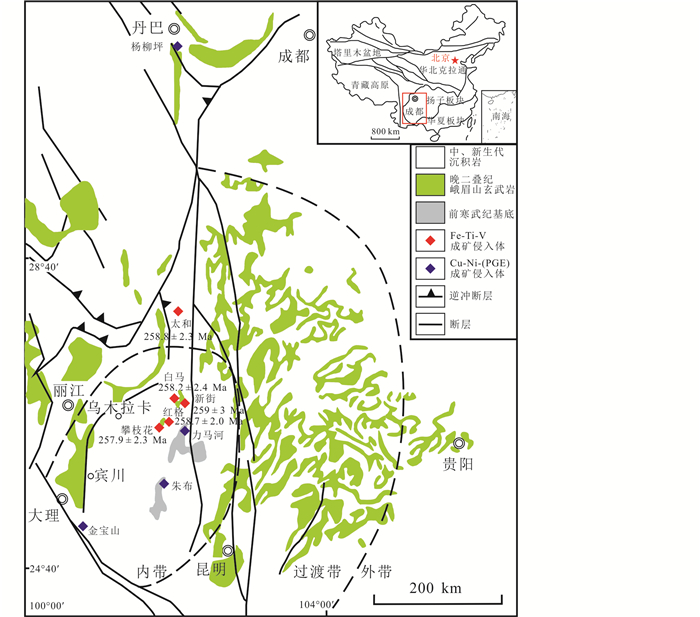
|
图 1 峨眉山大火成岩省及相关的镁铁-超镁铁质侵入体的分布图(据Song et al., 2009修改) 白马、攀枝花、红格、太和和新街侵入体的锆石年龄来自Zhou et al.(2002)和Zhong et al.(2011) Fig. 1 Geological map of mafic-ultramafic intrusions in the Emeishan LIP (modified after Song et al., 2009) |
白马层状镁铁质-超镁铁质侵入体距攀枝花市区东北约100km,呈南北走向展布(钟祥等,2018),长约24km,宽2~6km,厚度超过1km。岩体西倾,倾角50°~70°不等,局部岩体近于垂直。侵位于前寒武纪会理群的变质砂岩、大理岩、千枚岩和板岩以及震旦系灯影组厚层状白云岩夹白云质灰岩中(Liu et al., 2014),接触带灰岩已大理岩化。灯影组在白马矿区西北部出露,厚度大于200m(钟祥等,2018)。白马岩体被晚二叠世正长岩和花岗岩包围和穿插(Zhang et al., 2012)。正长岩的锆石SIMS U-Pb年龄为258.5±2.3Ma和257.8±2.6Ma,花岗岩的锆石SIMS U-Pb年龄为256.2±1.5Ma(Zhong et al., 2011)。白马矿体的形态及产状主要受安宁河断裂构造控制,后期被NE向断裂切割,由北向南划分为夏家坪、及及坪、田家村、青杠坪及马槟榔5个矿段(陈富文,1990;钟祥等,2018;图 2)。
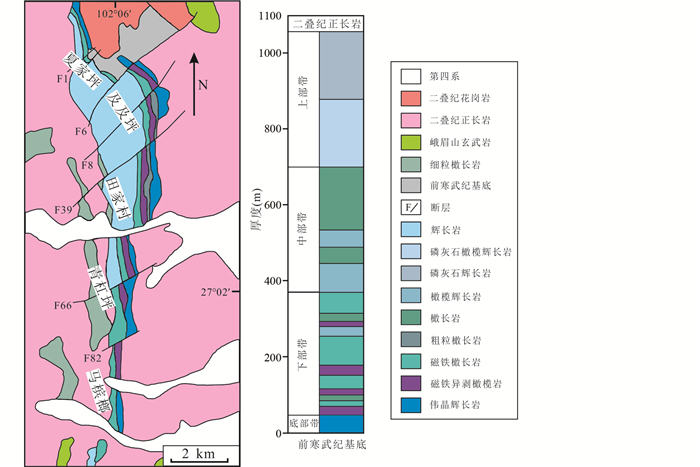
|
图 2 白马层状侵入体地质略图及柱状图(据Chen et al., 2014) Fig. 2 The geological map of Baima layered intrusion (after Chen et al., 2014) |
白马侵入体辉长岩中锆石SHRIMP U-Pb年龄为258±2Ma(李华芹等,2017),与SIMS U-Pb年龄258.2±2.4Ma一致(Zhong et al., 2011),表明白马侵入体形成于二叠纪晚期。成岩年龄与峨眉山大火成岩省苦橄岩、玄武岩及其他侵入体的形成时代接近(Zhou et al., 2008;Zhong et al., 2011;Tang et al., 2015),是峨眉山地幔柱岩浆活动的产物。
各矿段岩石组成基本相似,主要由异剥橄榄岩、橄长岩、橄榄辉长岩和辉长岩组成(图 2)。根据矿物组成、结构构造及含矿性可将白马岩体划分为底部岩相带、下部岩相带、中部岩相带和上部岩相带(Chen et al., 2014)。底部岩相带主要由伟晶辉长岩组成;下部岩相带由含有大量铁钛氧化物的磁铁异剥橄榄岩和磁铁橄长岩组成,并含有少量的橄长岩和辉长岩互层;中部岩相带主要由橄榄辉长岩和橄长岩组成;上部岩相带由磷灰石橄榄辉长岩和磷灰石辉长岩组成(Chen et al., 2014;宋谢炎等,2018)。
矿石矿物总体上以钛磁铁矿和钛铁矿为主,含少量的镁铝尖晶石和磁黄铁矿、黄铜矿、黄铁矿等硫化物矿物。脉石矿物主要有橄榄石、单斜辉石、斜长石及少量的角闪石、黑云母等。矿石以浸染状构造、条带状构造为主(Chen et al., 2014)。
3 样品特征及分析方法 3.1 样品特征本文样品采自白马Fe-Ti-V氧化物矿床露天采场,包括橄榄辉长岩和橄长岩,中-粗粒结构,以浸染状构造为主,单斜辉石和橄榄石自形程度较高。
橄长岩主要由橄榄石(20%~35%)、斜长石(8%~50%)和铁钛氧化物(15%~45%)等组成,并含有少量的单斜辉石等。橄榄石一般呈自形、半自形粒状,多具熔蚀结构;斜长石呈自形、半自形板柱状(图 3a,b),可见斜长石被橄榄石包裹(图 3b),橄榄石被磁铁矿包裹(图 3f)。
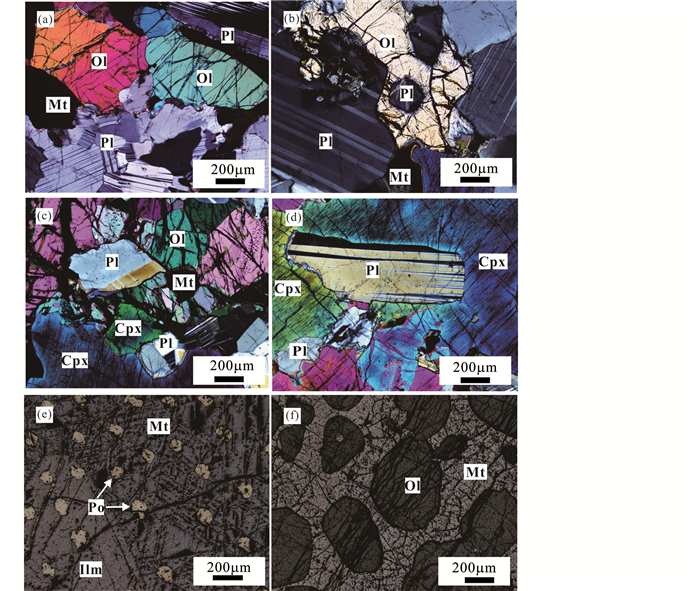
|
图 3 白马侵入体样品在正交偏光及反射光下的显微照片 Ol-橄榄石;Cpx-单斜辉石;Pl-斜长石;Mt-磁铁矿;Ilm-钛铁矿;Po-磁黄铁矿 Fig. 3 Photomicrographs of the samples from the Baima intrusion under crossed-polarized and reflected light |
橄榄辉长岩主要由斜长石(10%~35%)、单斜辉石(10%~20%)、橄榄石(5%~10%)以及铁钛氧化物(10%~40%)等组成(图 3c,d)。橄榄石呈自形、半自形的粒状结构(图 3c);部分斜长石呈自形、半自形被单斜辉石包裹(图 3d);单斜辉石以自形、半自形柱状为主,个别发育角闪石反应边。可见磁铁矿被单斜辉石包裹,磁铁矿中可见钛铁矿的出溶页片,磁黄铁矿被磁铁矿包裹(图 3e)。
3.2 分析方法样品去除表面氧化层,经过碎样、清洗、烘干,最后研磨成200目的粉末,用于主量元素、微量元素和Sr-Nd同位素组成分析。全岩主量元素和微量元素组成分析在西安地质矿产研究所实验测试中心完成。主量元素用荷兰帕纳科Axios 4.0kW X荧光光谱仪(XRF)分析测试,其相对误差小于0.05%,二价铁用湿化学滴定法测定。微量元素用Thermo Fisher X Series II电感耦合等离子体质谱仪(ICP-MS)测定,分析精度优于1.5%。Sr-Nd同位素组成分析在武汉上谱分析科技有限责任公司采用Neptune Plus MC-ICP-MS完成。Sr-Nd同位素的分馏采用86Sr/88Sr=0.1194和146Nd/144Nd=0.7219进行指数法校正,标样NBS SRM 987的87Sr/86Sr分析测试值为0.710242±13(2SD, n=9),与推荐值0.710241±12(2SD)(Thirlwall,1991)在误差范围内一致。JNdi-1的143Nd/144Nd分析测试值为0.512115±9(2SD,n=8)与推荐值0.512115±7(2SD)(Tanaka et al., 2000)在误差范围内一致。
4 分析结果 4.1 主量和微量元素地球化学特征白马侵入体橄榄辉长岩和橄长岩样品的全岩主量和微量元素组成分析结果见表 1。烧失量(LOI)值较低(< 3.1%),表明样品相对较新鲜。对全岩主要氧化物进行LOI校正,即扣除LOI,换算为100%无水硅酸盐氧化物组成。
在全岩主要氧化物与MgO的相关图解中,SiO2、CaO、Al2O3、K2O+Na2O与MgO总体上呈较明显的负相关关系,FeOT、TiO2与MgO总体上呈较显著的正相关关系(图 4),部分橄榄辉长岩和橄长岩样品中具有较高的FeOT与TiO2含量,这与样品中铁钛氧化物含量较高相一致。主量元素相关性表明白马侵入体中橄长岩的化学组成主要与橄榄石、斜长石及铁钛氧化物的含量有关;橄榄辉长岩的化学组成主要与斜长石、单斜辉石、橄榄石、角闪石及铁钛氧化物的含量有关(图 4)。
|
|
表 1 白马侵入体全岩主量(wt%)、稀土和微量(×10-6)元素组成 Table 1 Whole-rock major (wt%) and trace (×10-6) element concentrations from the Baima intrusion |
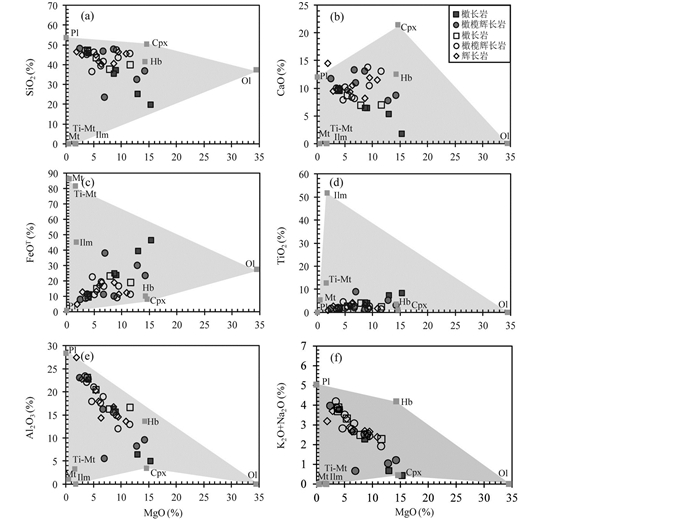
|
图 4 白马侵入体MgO与主要氧化物相关图解 实心的数据来自本文,空心的数据来自Zhang et al.(2012)和Liu et al.(2014);图 5、图 8和图 9同. Ol-橄榄石;Cpx-单斜辉石;Pl-斜长石;Hb-角闪石;Mt-磁铁矿;Ti-Mt-钛磁铁矿;Ilm-钛铁矿.矿物数据来自Shellnutt and Pang(2012)、Zhang et al.(2012)和Liu et al.(2014) Fig. 4 Plots of whole-rock major oxides versus MgO contents from the Baima intrusion |
白马侵入体中V、Ni、Cr、Co和Cu的含量变化范围较广,橄榄辉长岩和橄长岩中V含量变化范围为334×10-6~2020×10-6;Ni含量变化范围为51.9×10-6~474×10-6;Cr含量变化范围为24.2×10-6~ 8200×10-6;Co含量变化范围为48.7×10-6~ 200×10-6;Cu含量变化范围为68.9×10-6~ 463×10-6。V含量与FeOT、TiO2、Ni、Co和Cu等呈明显的正相关关系(图 5)。除了1个样品外,其余样品的V含量均随着P2O5含量的增加而减少(图 5f),表明V含量变化可能与铁钛氧化物、橄榄石及硫化物含量有关。
橄榄辉长岩和橄长岩具有相似的微量元素配分模式,样品的原始地幔标准化配分曲线与二滩苦橄岩和玄武岩相似(图 6a)。除了1个橄榄辉长岩样品具有明显的Sr负异常外,其余样品均具有明显的Sr和Ti正异常,Zr、Hf负异常,橄榄辉长岩样品中Nb和Ta既有正异常,也有负异常;而橄长岩具有轻微的Nb、Ta正异常。硅质大理岩围岩基本表现为Nb、Ta、Sr和Ti负异常,Zr、Hf异常不明显(Yu et al., 2015)。
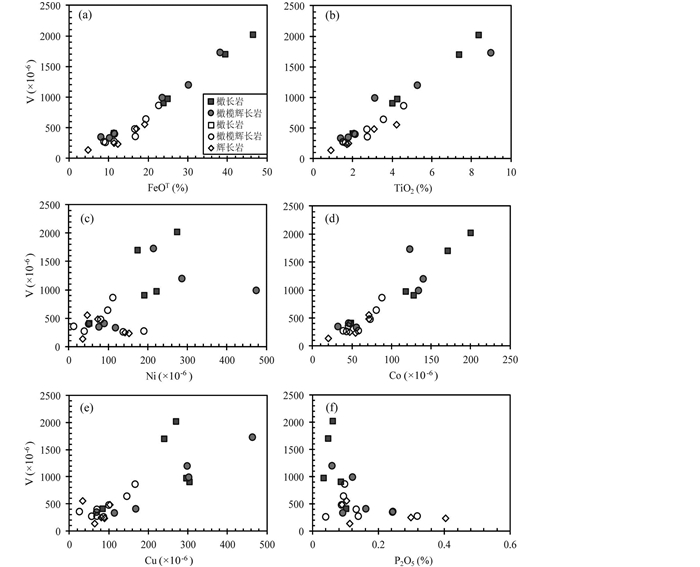
|
图 5 白马侵入体V与FeOT、TiO2、Ni、Co、Cu和P2O5的相关图解 Fig. 5 Plots of whole-rock V vs. FeOT, TiO2, Ni, Co, Cu and P2O5 contents from the Baima intrusion |

|
图 6 白马侵入体原始地幔标准化微量元素蛛网图(a, 标准化值据Palme and O'Neill, 2014)和球粒陨石标准化稀土元素配分图(b, 标准化值据Sun and McDonough, 1989) 硅质大理岩样品数据来自Yu et al.(2015);二滩玄武岩和苦橄岩数据来自Chung and Jahn(1995)、Xu et al.(2001)、Hou et al.(2006)、Shellnutt and Jahn(2011)和Li et al.(2012) Fig. 6 Primitive mantle-normalized trace element spider diagrams (a, normalization values after Palme and O'Neill, 2014) and chondrite-normalized rare earth element patterns (b, normalization values after Sun and McDonough, 1989) for the Baima intrusion |
白马岩体球粒陨石标准化稀土元素配分曲线也与二滩苦橄岩和玄武岩相似(图 6b);岩体的稀土元素含量总体较高,∑REE=16.46×10-6~272.4×10-6,平均68.67×10-6。在球粒陨石标准化稀土元素配分曲线上,橄榄辉长岩和橄长岩总体呈右倾型,富集轻稀土元素,略微亏损重稀土元素。除了1个橄榄辉长岩样品具有明显的Eu负异常(δEu=0.73)外,其余橄榄辉长岩和橄长岩具有明显的Eu正异常(δEu=1.11~4.18)。硅质大理岩围岩Eu异常变化较大,从明显的Eu负异常到略微的Eu正异常(δEu=0.44~1.10)(Yu et al., 2015)。
4.2 Sr-Nd同位素地球化学特征白马侵入体Sr-Nd同位素数据见表 2。橄榄辉长岩和橄长岩(87Sr/86Sr)i=0.704232~0.704855,平均值为0.704706;εNd(t)=1.40~3.94,平均值为2.41。与白马侵入体相比,硅质大理岩围岩具有相对较高的(87Sr/86Sr)i和较低的εNd(t)值,(87Sr/86Sr)i=0.705787~0.707833,平均值为0.706767;εNd(t)=-2.92~-0.64,平均值为-1.30(Yu et al., 2015)。白马样品Sr-Nd同位素组成总体分布范围较窄,全部落于峨眉山苦橄岩和高钛玄武岩的范围内(图 7)。与攀西地区其他几个赋存有世界级Fe-Ti-V氧化物矿床的典型侵入体进行对比发现,攀枝花侵入体(87Sr/86Sr)i与εNd(t)值与白马侵入体相近(Zhou et al., 2005, 2008;Zhang et al., 2009;Howarth and Prevec, 2013;Yu et al., 2015);太和侵入体与白马侵入体具有相似的(87Sr/86Sr)i,但εNd(t)值相对较低(Hou et al., 2012;She et al., 2014;Yu et al., 2015);而红格侵入体(87Sr/86Sr)i相对较高,εNd(t)值相对较低(Zhong et al., 2003;Yu et al., 2015)。
|
|
表 2 白马侵入体的Sr-Nd同位素组成 Table 2 Sr-Nd isotopic compositions of the Baima intrusion |
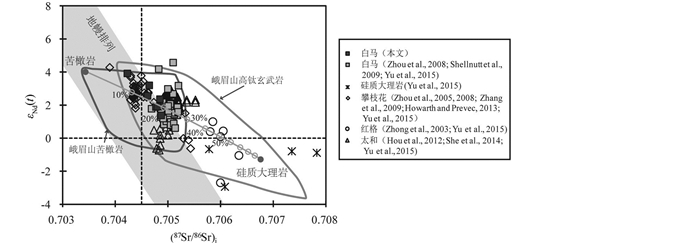
|
图 7 白马侵入体(87Sr/86Sr)i与εNd(t)协变图解(据DePaolo and Wasserburg, 1979) 地幔排列数据来自DePaolo and Wasserburg(1979);峨眉山苦橄岩数据来自Chung and Jahn(1995)、Xu et al.(2001)、Zhang et al.(2006, 2008)和Li et al.(2012);峨眉山高钛玄武岩数据来自Xu et al.(2001)、Xiao et al.(2004)和Zhang et al.(2008) Fig. 7 Plot of εNd(t) vs. (87Sr/86Sr)i in the Baima intrusion (after DePaolo and Wasserburg, 1979) |
计算母岩浆熔体成分的方法目前主要有以下几种:通过冷凝边成分估算岩体侵位时母岩浆的成分;当岩体堆晶相主要为橄榄石时,根据橄榄石-熔体平衡原理(Roeder and Emslie, 1970)和质量平衡原理获得成矿母岩浆的组成成分(Roeder and Emslie, 1970),或者利用岩体的微量元素和铂族元素比值来估算成矿母岩浆性质(Barnes et al., 1997)。由于白马岩体侵位之后受到花岗岩及正长岩侵入和包围,很难找到能够代表成矿母岩浆侵位时的冷凝边成分;而且白马侵入体在堆晶演化过程中受铁钛氧化物的影响较大,所以通过上述方法获得成矿母岩浆性质的难度较大(党永西,2018)。然而,Sr-Nd同位素及微量元素组成特征表明白马岩体与峨眉山高钛玄武岩具有同源性(Zhou et al., 2008)。与幔源橄榄岩(Fo>89)相比,白马岩体的橄榄石具有较低的Fo值(Fo=55~76.2;Zhang et al., 2012;Shellnutt and Pang, 2012),表明母岩浆在侵位之前发生过较高程度的结晶分异。Ni比Cu在橄榄石中具有更好的相容性,随着岩浆演化过程中橄榄石的结晶分异,残余岩浆中Ni会逐渐亏损(Keays,1995;Li et al., 2007)。与原始地幔(Cu/Ni=0.01)相比,白马岩体Cu/Ni比值(0.5~2.5)相对较高,暗示母岩浆早期经历过橄榄石的结晶分异(Zhang et al., 2012;党永西,2018)。在白马样品中存在角闪石,暗示母岩浆中水含量较高。根据矿物之间的包裹关系和自形程度等显微特征,可认为橄榄石和斜长石结晶较早,单斜辉石和角闪石结晶较晚(Liu et al., 2014)。
根据橄榄石成分及橄榄石Mg-Fe分配系数Kd,可以估算与橄榄石成分平衡的熔体成分。我们选用拉斑玄武质岩浆中不同组成和温度下获得的实验分配系数Kd=(FeO/MgO)橄榄石/(FeO/MgO)液相=0.34±0.012(Matzen et al., 2011),计算出与橄榄石成分平衡的熔体成分。在MgO与FeO相关图解中(图 8a),白马侵入体大部分橄长岩、橄榄辉长岩及辉长岩位于与橄榄石Fo=55~77平衡的液相组成之间,而一些橄榄辉长岩和橄长岩样品组成与橄榄石Fo=77平衡的液相组成相比,具有较高的MgO/FeO比值。平衡的液相与矿物组成的差异表明橄榄石和单斜辉石等含铁镁的硅酸盐矿物是导致这种不平衡的主要矿物相。在Fe2O3与FeO相关图解中(图 8b),假设白马岩体母岩浆具有与二滩玄武岩相同的组成,在压力为2kbar、温度为1300℃、QFM+1.5条件下根据Fe3+/Fe2+-fO2-T组成模型(Kress and Carmichael, 1991)计算得出Fe2O3/FeO比值。白马样品中仅出现岩浆硫化物,无硫酸盐。由于硫酸盐出现在氧逸度相对更高的条件下,所以QFM+1.5应该为白马侵入体的氧逸度上限(Jugo et al., 2005)。然而,白马样品的Fe2O3/FeO比值均超出了液相线在QFM+1.5的范围(图 8b)。
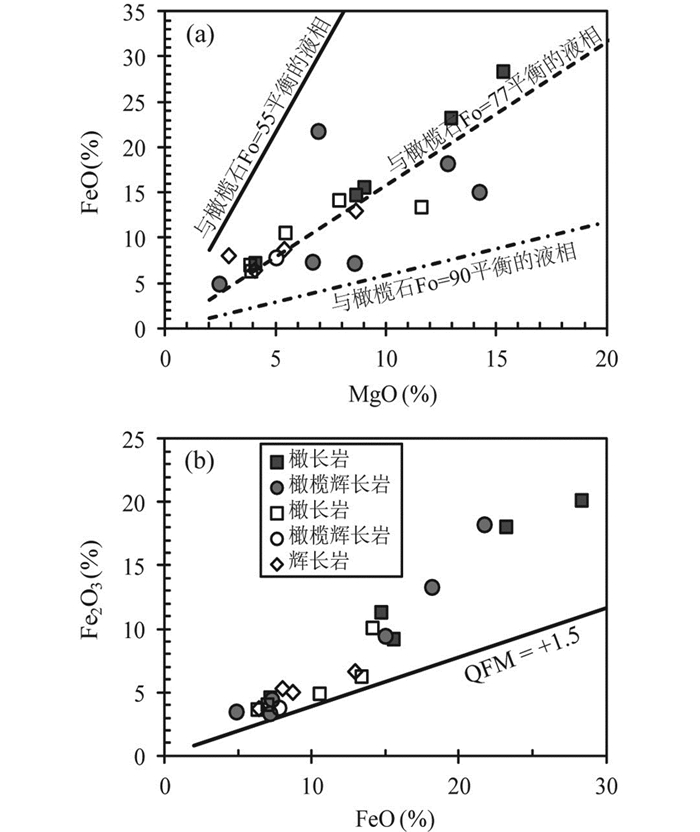
|
图 8 白马侵入体FeO-MgO(a)及Fe2O3-FeO(b)相关图解 液相中FeO/MgO以及橄榄石的组成根据Kd=(FeO/MgO)橄榄石/(FeO/MgO)液相=0.34 (Matzen et al., 2011)进行计算.液相组成与二滩玄武岩的组成相同,Fe2O3/FeO比值是根据Kress and Carmichael(1991)的模型在P=2kbar、T=1300℃和QFM=+1.5条件下计算获得的.二滩玄武岩和苦橄岩的数据来自Chung and Jahn(1995)、Xu et al.(2001)、Hou et al.(2006)、Shellnutt and Jahn(2011)和Li et al.(2012) Fig. 8 Plots of FeO vs. MgO (a) and Fe2O3 vs. FeO (b) of the Baima intrusion |
在磁铁矿中,高场强元素Ti为强相容元素,Nb和Ta为中等相容元素,而在橄榄石、单斜辉石、斜长石等矿物相中,Ti、Nb和Ta等高场强元素均为强不相容元素。REE在单斜辉石中为中等不相容元素,在磁铁矿中为强不相容元素(陈列锰等,2014)。因此,单斜辉石的堆晶演化过程可能会导致橄榄辉长岩和辉长岩中REE的富集,即橄榄辉长岩和辉长岩比橄长岩中含有更高的REE含量,而磁铁矿堆晶过程会造成铁钛氧化物含量较高的橄榄辉长岩和橄长岩中Ti的强烈富集,从而表现出明显的Ti正异常,以及弱的Nb、Ta正异常(图 6)。Sr和Eu在斜长石中为相容元素,所以斜长石的堆晶过程使得Sr和Eu在大多数橄榄辉长岩和橄长岩中富集,从而表现出正异常(图 6)。在磷灰石中REE为强相容元素(Nakamura et al., 1986),磷灰石结晶堆积过程就是REE富集的过程。因而含磷灰石的辉长岩中具有较高的REE含量,并造成Sr在辉长岩中表现出弱的负异常(党永西,2018)。因此,P2O5含量最高的橄榄辉长岩样品(BM15-01)具有最高的REE含量以及弱的Sr和Eu负异常(图 6)。
Cr在磁铁矿和钛铁矿中是相容元素,DCr磁铁矿/熔体=50~230;DCr钛铁矿/熔体=3~40 (Leeman et al., 1978;Nakamura et al., 1986;Klemme et al., 2006)。橄榄辉长岩和橄长岩中Cr的正异常可能与磁铁矿和钛铁矿的堆积作用过程有关(党永西,2018)。在MgO与Cr含量的相关图中(图 9a),白马样品Cr与MgO呈明显的正相关关系,表明磁铁矿、钛铁矿与橄榄石堆晶造成橄榄辉长岩和橄长岩中Cr的富集。随着成矿母岩浆中磁铁矿和钛铁矿的结晶分异过程,残余岩浆中Cr的含量逐渐亏损,导致后期结晶的辉长岩中Cr含量偏低。在橄榄石和磁铁矿中Ni为相容元素,DNi橄榄石/熔体=1.35~13.6,DNi磁铁矿/熔体=31~65(Nielsen et al., 1992),橄榄石与磁铁矿的早期结晶堆积过程可以导致残余岩浆中Ni亏损。因此,早期结晶分异形成的橄榄辉长岩和橄长岩中Ni的含量明显高于较晚形成的辉长岩(图 9b)。相比之下,在橄榄石、单斜辉石及铁钛氧化物中,由于P是不相容元素,分配系数较低(Bindeman et al., 1998),随着橄榄石、单斜辉石及铁钛氧化物分离结晶作用的进行,残余岩浆中P不断富集,最终导致岩体中磷灰石的结晶堆积(图 9c)。在铁钛氧化物中Ti和Y为相容元素,Ti/Y比值很大程度上受铁钛氧化物堆晶作用的影响,而Sr含量主要与斜长石堆晶作用有关(图 9d)。因此,橄长岩、橄榄辉长岩和辉长岩中MgO与Cr、Ni及P等元素之间的相关性进一步表明这些岩石在成因上具有一定的联系,即橄长岩、橄榄辉长岩和辉长岩由母岩浆经历了侵入演化堆晶而形成。
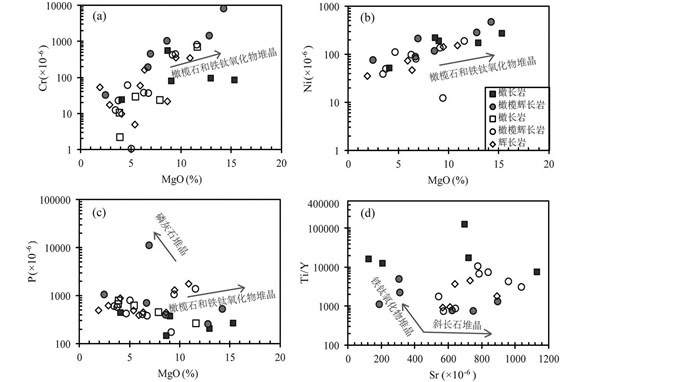
|
图 9 白马侵入体全岩MgO与Cr、Ni、P (a-c)以及Sr与Ti/Y比值(d)二元相关图解(据陈列锰等,2014) Fig. 9 Plots of whole-rock MgO contents versus Cr, Ni and P (a-c), and Sr contents versus Ti/Y ratio (d) for the Baima intrusion (after Chen et al., 2014) |
碳酸盐围岩的混染对于成矿作用的影响尚有不同的认识。Yu et al.(2015)通过Sr-Nd-O同位素研究认为碳酸盐围岩直接混染攀西地区含矿岩体母岩浆的可能性极小。然而Xing et al.(2012)通过矿物的挥发份和C-O-H同位素组成研究认为白马岩体存在较多的来自灯影组灰岩的贡献。Ganino et al.(2013)和Pêcher et al.(2013)认为攀枝花和红格侵入体加入了较高比例的碳酸盐围岩(8%~13.7%)。Tang et al.(2017b)对攀枝花岩体苦橄质岩墙的研究认为玄武质岩浆混染碳酸盐岩能够造成与磁铁矿共存的橄榄石中富Mg的特征。由于泥岩和白云岩Sr含量较低(Ganino et al., 2013),即使有大量的围岩加入也不足以显著改变岩浆的Sr同位素组成。然而白马侵入体硅质大理岩围岩中Sr含量较高,变化范围为161×10-6~337×10-6,平均值为258×10-6(Yu et al., 2015)。白马侵入体Sr-Nd同位素全部落于峨眉山苦橄岩和高钛玄武岩的范围内(图 7),表明白马侵入体与峨眉山苦橄岩和高钛玄武岩具有密切的内在成因联系(Zhou et al., 2008;党永西,2018)。因此,我们选取苦橄岩作为起始端元,硅质大理岩围岩作为混合端元,通过Sr-Nd同位素混合模拟计算得到白马母岩浆经历了10%~30%的硅质大理岩的混染(图 7)。同化混染过程可能涉及围岩的分解、与碳酸盐熔体的混合或者是与白云岩去碳酸盐化作用产生的富CO2流体的交换(Ganino et al., 2008, 2013;Pêcher et al., 2013)。大理岩围岩的同化混染作用可以产生CO2流体,增加岩浆中CO2/CO比值,促使岩浆更加氧化,有利于硫化物、磁铁矿和钛铁矿的结晶(Xing et al., 2012;Ripley and Li, 2013;Tang et al., 2018)。这与Liu et al.(2015)应用磁铁矿和钛铁矿的成分估算的白马侵入体具有较高的氧逸度相一致。
5.4 成矿控制因素白马层状岩体铁钛氧化物的成矿作用除了与碳酸盐围岩的混染有关外,还受到其他因素的制约。成矿母岩浆氧逸度的高低对于控制铁钛氧化物饱和时间的早晚以及分异结晶过程持续的时间具有重要的作用(柏中杰等,2019)。白马Fe-Ti-V氧化物矿床铁钛氧化物分异结晶形成于相对氧化的环境中,所需氧逸度较高。起源于地幔柱深部的成矿母岩浆遭受一定程度的围岩大理岩的混染作用,能够提高氧逸度,促进铁钛氧化物的分离结晶(Toplis and Carroll, 1995;党永西,2018)。白马侵入体橄榄辉长岩和橄长岩相对较高的Cu/Ni比值暗示母岩浆早期经历过橄榄石的结晶分异,全岩MgO与Cr、Ni的相关性表明白马母岩浆经历了较高程度的分离结晶作用。样品中存在角闪石,暗示母岩浆中水含量较高。Sr-Nd同位素混合模拟计算表明白马母岩浆经历了10% ~ 30%硅质大理岩围岩的混染。全岩Cr含量和斜长石牌号An突变及斜长石Sr同位素不平衡表明白马岩体经历了多次的岩浆补给(Zhang et al., 2012;Liu et al., 2014)。因此,白马Fe-Ti-V氧化物矿床的形成不仅受母岩浆的组成、分离结晶作用、岩浆多次补给等因素的制约(Shellnutt et al., 2011;Zhang et al., 2012; Liu et al., 2014, 2015),还受到大理岩围岩的影响(Xing et al., 2012)。
6 结论峨眉山大火成岩省白马Fe-Ti-V氧化物矿床的主量、微量元素及Sr-Nd同位素组成特征表明:
(1) 白马侵入体中MgO含量与Cr、Ni和P元素含量特征表明这些岩石是母岩浆堆晶演化的产物。
(2) 白马侵入体微量元素原始地幔标准化配分曲线和稀土元素球粒陨石标准化配分曲线具有Sr、Eu和Ti正异常,Zr-Hf负异常。Sr-Nd同位素混合模拟计算表明白马母岩浆经历了10%~30%围岩硅质大理岩的混染。
(3) 白马Fe-Ti-V氧化物矿床的形成受母岩浆的组成、分离结晶作用、大理岩围岩的混染等多种因素共同制约。
致谢 样品采集和分析过程中Chusi Li、张加飞、陈思童等给予了很大的帮助;邱检生教授、李永军教授、赖绍聪教授、侯通教授和编辑部同志对文稿的修改提出了建设性的意见和建议;在此一并表示衷心的感谢。
Bai ZJ, Zhong H and Zhu WG. 2019. Redox state of mantle-derived magma and constraints on the genesis of magmatic deposits. Acta Petrologica Sinica, 35(1): 204-214 (in Chinese with English abstract) DOI:10.18654/1000-0569/2019.01.16 |
Barnes SJ, Zientek M and Severson MJ. 1997. Ni, Cu, Au, and platinum-group element contents of sulphides associated with intraplate magmatism:A synthesis. Canadian Journal of Earth Sciences, 34(4): 337-351 |
Bindeman IN, Davis AM and Drake MJ. 1998. Ion microprobe study of plagioclase-basalt partition experiments at natural concentration levels of trace elements. Geochimica et Cosmochimica Acta, 62(7): 1175-1193 |
Chen FW. 1990. Petrologic study on Baima ore-bearing layered mafic-ultramafic intrusion. Acta Petrologica Sinica, 6(4): 12-26 (in Chinese with English abstract) |
Chen LM, Song XY, Zhu XK, Zhang XQ, Yu SY and Yi JN. 2014. Iron isotope fractionation during crystallization and sub-solidus re-equilibration:Constraints from the Baima mafic layered intrusion, SW China. Chemical Geology, 380: 97-109 DOI:10.1016/j.chemgeo.2014.04.020 |
Chen LM, Yi JN, Song XY, Yu SY, She YW, Xie W, Luan Y and Xiang JX. 2014. Petrogenesis of the Heigutian Ti-V-magnetite ore-bearing layered intrusion, the inner zone of the Emeishan large igneous province. Acta Petrologica Sinica, 30(5): 1415-1431 (in Chinese with English abstract) |
Chung SL and Jahn BM. 1995. Plume-lithosphere interaction in generation of the Emeishan flood basalts at the Permian-Triassic boundary. Geology, 23(10): 889-892 DOI:10.1130/0091-7613(1995)023<0889:PLIIGO>2.3.CO;2 |
Dang YX. 2018. Study on the metallogenesis of the Baima ultra-large V-Ti-magnetite deposit in the Emeishan large igneous province, SW China. Master Degree Thesis. Lanzhou: Lanzhou University (in Chinese with English summary)
|
DePaolo DJ and Wasserburg GJ. 1979. Petrogenetic mixing models and Nd-Sr isotopic patterns. Geochimica et Cosmochimica Acta, 43(4): 615-627 DOI:10.1016/0016-7037(79)90169-8 |
Ganino C, Arndt NT, Zhou MF, Gaillard F and Chauvel C. 2008. Interaction of magma with sedimentary wall rock and magnetite ore genesis in the Panzhihua mafic intrusion, SW China. Mineralium Deposita, 43(6): 677-694 DOI:10.1007/s00126-008-0191-5 |
Ganino C, Arndt NT, Chauvel C, Jean A and Athurion C. 2013. Melting of carbonate wall rocks and formation of the heterogeneous aureole of the Panzhihua intrusion, China. Geoscience Frontiers, 4(5): 535-546 DOI:10.1016/j.gsf.2013.01.012 |
Hanski E, Kamenetsky VS, Luo ZY, Xu YG and Kuzmin DV. 2010. Primitive magmas in the Emeishan large igneous province, southwestern China and northern Vietnam. Lithos, 119(1-2): 75-90 DOI:10.1016/j.lithos.2010.04.008 |
Hou T, Zhang ZC, Encarnacion J and Santosh M. 2012. Petrogenesis and metallogenesis of the Taihe gabbroic intrusion associated with Fe-Ti-oxide ores in the Panxi district, Emeishan large igneous province, Southwest China. Ore Geology Reviews, 49: 109-127 DOI:10.1016/j.oregeorev.2012.09.004 |
Hou ZQ, Lu JR and Liu SZ. 2006. Heterogeneity of a plume axis:Bulk-rock geochemical evidence from picrites and basalts in the Emei Large Igneous Province, Southwest China. International Geology Review, 48(12): 1087-1112 DOI:10.2747/0020-6814.48.12.1087 |
Howarth GH and Prevec SA. 2013. Trace element, PGE, and Sr-Nd isotope geochemistry of the Panzhihua mafic layered intrusion, SW China:Constraints on ore-forming processes and evolution of parent magma at depth in a plumbing-system. Geochimica et Cosmochimica Acta, 120: 459-478 DOI:10.1016/j.gca.2013.06.019 |
Jugo PJ, Luth RW and Richards JP. 2005. Experimental data on the speciation of sulfur as a function of oxygen fugacity in basaltic melts. Geochimica et Cosmochimica Acta, 69(2): 497-503 DOI:10.1016/j.gca.2004.07.011 |
Kamenetsky VS, Chung SL, Kamenetsky MB and Kuzmin DV. 2012. Picrites from the Emeishan large igneous province, SW China:A compositional continuum in primitive magmas and their respective mantle sources. Journal of Petrology, 53(10): 2095-2113 DOI:10.1093/petrology/egs045 |
Keays RR. 1995. The role of komatiitic and picritic magmatism and S-saturation in the formation of ore deposits. Lithos, 34(1-3): 1-18 |
Klemme S, Günther D, Hametner K, Prowatke S and Zack T. 2006. The partitioning of trace elements between ilmenite, ulvospinel, armalcolite and silicate melts with implications for the early differentiation of the moon. Chemical Geology, 234(3-4): 251-263 DOI:10.1016/j.chemgeo.2006.05.005 |
Kress VC and Carmichael ISE. 1991. The compressibility of silicate liquids containing Fe2O3 and the effect of composition, temperature, oxygen fugacity and pressure on their redox states. Contributions to Mineralogy and Petrology, 108(1-2): 82-92 DOI:10.1007/BF00307328 |
Leeman WP, Ma MS, Murali AV and Schmitt RA. 1978. Empirical estimation of magnetite/liquid distribution coefficients for some transition elements. Contributions to Mineralogy and Petrology, 65(3): 269-272 DOI:10.1007/BF00375512 |
Li CS, Naldrett AJ and Ripley EM. 2007. Controls on the Fo and Ni contents of olivine in sulfide-bearing mafic/ultramafic intrusions:Principles, modeling, and examples from Voisey's Bay. Earth Science Frontiers, 14(5): 177-185 |
Li CS, Tao Y, Qi L and Ripley EM. 2012. Controls on PGE fractionation in the Emeishan picrites and basalts:Constraints from integrated lithophile-siderophile elements and Sr-Nd isotopes. Geochimica et Cosmochimica Acta, 90: 12-32 DOI:10.1016/j.gca.2012.04.046 |
Li HQ, Wang DH, Ren HT, Wang XD, Jia XH, Yang WQ and Wang L. 2017. Zircon SHRIMP U-Pb age of the layered mafic rock mass in Panxi area, Sichuan Province, and its geological significance. Geological Bulletin of China, 36(5): 691-697 (in Chinese with English abstract) |
Li J, Xu JF, Suzuki K, He B, Xu YG and Ren ZY. 2010. Os, Nd and Sr isotope and trace element geochemistry of the Muli picrites:Insights into the mantle source of the Emeishan Large Igneous Province. Lithos, 119(1-2): 108-122 DOI:10.1016/j.lithos.2010.06.002 |
Liu PP, Zhou MF, Wang CY, Xing CM and Gao JF. 2014. Open magma chamber processes in the formation of the Permian Baima mafic-ultramafic layered intrusion, SW China. Lithos, 184-187: 194-208 DOI:10.1016/j.lithos.2013.10.028 |
Liu PP, Zhou MF, Chen WT, Gao JF and Huang XW. 2015. In-situ LA-ICP-MS trace elemental analyses of magnetite:Fe-Ti-(V) oxide-bearing mafic-ultramafic layered intrusions of the Emeishan Large Igneous Province, SW China. Ore Geology Reviews, 65: 853-871 DOI:10.1016/j.oregeorev.2014.09.002 |
Ma YX, Liu JD, Wang HF, Mao YS, Ji XT, Wang DK and Min ZZ. 2001. Geology of the Panzhihua Region. Chengdu: Sichuan Science and Technology Press, 1-367 (in Chinese)
|
Matzen AK, Baker MB, Beckett JR and Stolper EM. 2011. Fe-Mg partitioning between olivine and high-magnesian melts and the nature of Hawaiian parental liquids. Journal of Petrology, 52(7-8): 1243-1263 DOI:10.1093/petrology/egq089 |
Nakamura Y, Fujimaki H, Nakamura N, Tatsumoto M, McKay GA and Wagstaff J. 1986. Hf, Zr, and REE partition coefficients between ilmenite and liquid:Implications for lunar petrogenesis. Journal of Geophysical Research:Solid Earth, 91(B4): 239-250 DOI:10.1029/JB091iB04p0D239 |
Nielsen RL, Gallahan WE and Newberger F. 1992. Experimentally determined mineral-melt partition coefficients for Sc, Y and REE for olivine, orthopyroxene, pigeonite, magnetite and ilmenite. Contributions to Mineralogy and Petrology, 110(4): 488-499 DOI:10.1007/BF00344083 |
Palme H and O'Neill HSC. 2014. Cosmochemical estimates of mantle composition. In: Richard WC (ed.). Treatise on Geochemistry. 2nd Edition. Amsterdam: Elsevier, 3: 1-39
|
Pang KN, Zhou MF, Qi L, Shellnutt G, Wang CY and Zhao DG. 2010. Flood basalt-related Fe-Ti oxide deposits in the Emeishan large igneous province, SW China. Lithos, 119(1-2): 123-136 DOI:10.1016/j.lithos.2010.06.003 |
Pêcher A, Arndt N, Jean A, Bauville A, Ganino C and Athurion C. 2013. Structure of the Panzhihua intrusion and its Fe-Ti-V deposit, China. Geoscience Frontiers, 4(5): 571-581 DOI:10.1016/j.gsf.2013.02.004 |
Ripley EM and Li CS. 2013. Sulfide saturation in mafic magmas:Is external sulfur required for magmatic Ni-Cu-(PGE) ore genesis?. Economic Geology, 108(1): 45-58 DOI:10.2113/econgeo.108.1.45 |
Roeder PL and Emslie RF. 1970. Olivine-liquid equilibrium. Contributions to Mineralogy and Petrology, 29(4): 275-289 DOI:10.1007/BF00371276 |
She YW, Yu SY, Song XY, Chen LM, Zheng WQ and Luan Y. 2014. The formation of P-rich Fe-Ti oxide ore layers in the Taihe layered intrusion, SW China:Implications for magma-plumbing system process. Ore Geology Reviews, 57: 539-559 DOI:10.1016/j.oregeorev.2013.07.007 |
Shellnutt JG, Zhou MF and Zellmer GF. 2009. The role of Fe-Ti oxide crystallization in the formation of A-type granitoids with implications for the Daly gap:An example from the Permian Baima igneous complex, SW China. Chemical Geology, 259(3-4): 204-217 |
Shellnutt JG and Jahn BM. 2011. Origin of Late Permian Emeishan basaltic rocks from the Panxi region (SW China):Implications for the Ti-classification and spatial-compositional distribution of the Emeishan flood basalts. Journal of Volcanology and Geothermal Research, 199(1-2): 85-95 DOI:10.1016/j.jvolgeores.2010.10.009 |
Shellnutt JG, Wang KL, Zellmer GF, Iizuka Y, Jahn BM, Pang KN, Qi L and Zhou MF. 2011. Three Fe-Ti oxide ore-bearing gabbro-granitoid complexes in the Panxi region of the Permian Emeishan large igneous province, SW China. American Journal of Science, 311(9): 773-812 DOI:10.2475/09.2011.02 |
Shellnutt JG and Pang KN. 2012. Petrogenetic implications of mineral chemical data for the Permian Baima igneous complex, SW China. Mineralogy and Petrology, 106(1-2): 75-88 DOI:10.1007/s00710-012-0217-7 |
Song XY, Keays RR, Xiao L, Qi HW and Ihlenfeld C. 2009. Platinum-group element geochemistry of the continental flood basalts in the central Emeishan large igneous province, SW China. Chemical Geology, 262(3-4): 246-261 DOI:10.1016/j.chemgeo.2009.01.021 |
Song XY, Chen LM, Yu SY, Tao Y, She YW, Luan Y, Zhang XQ and He HL. 2018. Geological features and genesis of the V-Ti magnetite deposits in the Emeishan Large Igeneous Province, SW China. Bulletin of Mineralogy, Petrology and Geochemistry, 37(6): 1003-1018 (in Chinese with English abstract) |
Sun SS and McDonough WF. 1989. Chemical and isotopic systematics of oceanic basalts: Implications for mantle composition and processes. In: Saunders AD and Norry MJ (eds.). Magmatism in the Ocean Basins. Geological Society, London, Special Publications, 42(1): 313-345
|
Tanaka T, Togashi S, Kamioka H, Amakawa H, Kagami H, Hamamoto T, Yuhara M, Orihashi Y, Yoneda S, Shimizu H, Kunimaru T, Takahashi K, Yanagi T, Nakano T, Fujimaki H, Shinjo R, Asahara Y, Tanimizu M and Dragusanu C. 2000. JNdi-1:A neodymium isotopic reference in consistency with LaJolla neodymium. Chemical Geology, 168(3-4): 279-281 DOI:10.1016/S0009-2541(00)00198-4 |
Tang QY, Zhang MJ, Yu M, Wang QL and Shang H. 2013. The magmatic ore-forming system of Late-Permian Emeishan mantle plume. Acta Petrologica et Mineralogica, 32(5): 680-692 (in Chinese with English abstract) |
Tang QY, Li CS, Zhang MJ and Lin Y. 2015. U-Pb age and Hf isotopes of zircon from basaltic andesite and geochemical fingerprinting of the associated picrites in the Emeishan large igneous province, SW China. Mineralogy and Petrology, 109(1): 103-114 |
Tang QY, Zhang MJ, Wang YK, Yao YS, Du L, Chen LM and Li ZP. 2017a. The origin of the Zhubu mafic-ultramafic intrusion of the Emeishan large igneous province, SW China:Insights from volatile compositions and C-Hf-Sr-Nd isotopes. Chemical Geology, 469: 47-59 DOI:10.1016/j.chemgeo.2017.02.009 |
Tang QY, Li CS, Tao Y, Ripley EM and Xiong F. 2017b. Association of Mg-rich olivine with magnetite as a result of brucite marble assimilation by basaltic magma in the Emeishan Large Igneous Province, SW China. Journal of Petrology, 58(4): 699-714 DOI:10.1093/petrology/egx031 |
Tang QY, Bao J, Dang YX, Ke S and Zhao Y. 2018. Mg-Sr-Nd isotopic constraints on the genesis of the giant Jinchuan Ni-Cu-(PGE) sulfide deposit, NW China. Earth and Planetary Science Letters, 502: 221-230 DOI:10.1016/j.epsl.2018.09.008 |
Tao Y, Hu RZ, Qi L and Luo TY. 2007. Geochemical characteristics and metallogenesis of the Limahe mafic-ultramafic intrusion, Sichuan. Acta Petrologica Sinica, 23(11): 2785-2800 (in Chinese with English abstract) |
Tao Y, Hu RZ, Qi L, Qu WJ, Chu ZY and Gou TZ. 2010. Sr-Nd-Os isotopic constraints on magma origin and evolution of the Jinbaoshan Pt-Pd deposit, Yunnan. Journal of Mineralogy and Petrology, 30(2): 60-67 (in Chinese with English abstract) |
Tegner C, Cawthorn RG and Kruger FJ. 2006. Cyclicity in the main and upper zones of the bushveld complex, South Africa:Crystallization from a zoned magma sheet. Journal of Petrology, 47(11): 2257-2279 DOI:10.1093/petrology/egl043 |
Thirlwall MF. 1991. Long-term reproducibility of multicollector Sr and Nd isotope ratio analysis. Chemical Geology, 94(2): 85-104 DOI:10.1016/S0009-2541(10)80021-X |
Toplis MJ and Carroll MR. 1995. An experimental study of the influence of oxygen fugacity on Fe-Ti oxide stability, phase relations, and mineral-melt equilibria in ferro-basaltic systems. Journal of Petrology, 36(5): 1137-1170 DOI:10.1093/petrology/36.5.1137 |
Wang Y. 2008. Origin of the Permian Baimazhai magmatic Ni-Cu-(PGE) sulfide deposits, Yunnan:Implications for the relationship of crustal contamination and mineralization. Bulletin of Mineralogy, Petrology and Geochemistry, 27(4): 332-343 (in Chinese with English abstract) |
Xiao L, Xu YG, Mei HJ, Zheng YF, He B and Pirajno F. 2004. Distinct mantle sources of low-Ti and high-Ti basalts from the western Emeishan large igneous province, SW China:Implications for plume-lithosphere interaction. Earth and Planetary Science Letters, 228(3-4): 525-546 DOI:10.1016/j.epsl.2004.10.002 |
Xing CM, Wang CY and Zhang MJ. 2012. Volatile and C-H-O isotopic compositions of giant Fe-Ti-V oxide deposits in the Panxi region and their implications for the sources of volatiles and the origin of Fe-Ti oxide ores. Science China (Earth Sciences), 55(11): 1782-1795 DOI:10.1007/s11430-012-4468-2 |
Xu YG, Chung SL, Jahn BM and Wu GY. 2001. Petrologic and geochemical constraints on the petrogenesis of Permian-Triassic Emeishan flood basalts in southwestern China. Lithos, 58(3-4): 145-168 DOI:10.1016/S0024-4937(01)00055-X |
Yu SY, Song XY, Chen LM and Li XB. 2014. Postdated melting of subcontinental lithospheric mantle by the Emeishan mantle plume:Evidence from the Anyi intrusion, Yunnan, SW China. Ore Geology Reviews, 57: 560-573 DOI:10.1016/j.oregeorev.2013.08.006 |
Yu SY, Song XY, Ripley EM, Li CS, Chen LM, She YW and Luan Y. 2015. Integrated O-Sr-Nd isotope constraints on the evolution of four important Fe-Ti oxide ore-bearing mafic-ultramafic intrusions in the Emeishan large igneous province, SW China. Chemical Geology, 401: 28-42 DOI:10.1016/j.chemgeo.2015.02.020 |
Zhang XQ, Song XY, Chen LM, Xie W, Yu SY, Zheng WQ, Deng YF, Zhang JF and Gui SG. 2012. Fractional crystallization and the formation of thick Fe-Ti-V oxide layers in the Baima layered intrusion, SW China. Ore Geology Reviews, 49: 96-108 DOI:10.1016/j.oregeorev.2012.09.003 |
Zhang ZC, Mahoney JJ, Mao JW and Wang FS. 2006. Geochemistry of picritic and associated basalt flows of the western Emeishan flood basalt province, China. Journal of Petrology, 47(10): 1997-2019 DOI:10.1093/petrology/egl034 |
Zhang ZC, Zhi XC, Chen L, Saunders AD and Reichow MK. 2008. Re-Os isotopic compositions of picrites from the Emeishan flood basalt province, China. Earth and Planetary Science Letters, 276(1-2): 30-39 DOI:10.1016/j.epsl.2008.09.005 |
Zhang ZC, Mao JW, Saunders AD, Ai Y, Li Y and Zhao L. 2009. Petrogenetic modeling of three mafic-ultramafic layered intrusions in the Emeishan large igneous province, SW China, based on isotopic and bulk chemical constraints. Lithos, 113(3-4): 369-392 DOI:10.1016/j.lithos.2009.04.023 |
Zhong H, Yao Y, Hu SF, Zhou XH, Liu BG, Sun M, Zhou MF and Viljoen MJ. 2003. Trace-element and Sr-Nd isotopic geochemistry of the PGE-bearing Hongge layered intrusion, southwestern China. International Geology Review, 45(4): 371-382 DOI:10.2747/0020-6814.45.4.371 |
Zhong H and Zhu WG. 2006. Geochronology of layered mafic intrusions from the Pan-Xi area in the Emeishan large igneous province, SW China. Mineralium Deposita, 41(6): 599-606 DOI:10.1007/s00126-006-0081-7 |
Zhong H, Campbell IH, Zhu WG, Allen CM, Hu RZ, Xie LW and He DF. 2011. Timing and source constraints on the relationship between mafic and felsic intrusions in the Emeishan large igneous province. Geochimica et Cosmochimica Acta, 75(5): 1374-1395 DOI:10.1016/j.gca.2010.12.016 |
Zhong X, Xi AH, Ge YH and Zheng CY. 2018. Crystallization sequence of minerals and origin of the Fe-Ti-V oxide ores from the Baima layered intrusion in the Panxi Area. Acta Mineralogica Sinica, 38(4): 449-461 (in Chinese with English abstract) |
Zhou MF, Malpas J, Song XY, Robinson PT, Sun M, Kennedy AK, Lesher CM and Keays RR. 2002. A temporal link between the Emeishan large igneous province (SW China) and the end-Guadalupian mass extinction. Earth and Planetary Science Letters, 196(3-4): 113-122 DOI:10.1016/S0012-821X(01)00608-2 |
Zhou MF, Robinson PT, Lesher CM, Keays RR, Zhang CJ and Malpas J. 2005. Geochemistry, petrogenesis and metallogenesis of the Panzhihua gabbroic layered intrusion and associated Fe-Ti-V-oxide deposits, Sichuan Province, SW China. Journal of Petrology, 46(11): 2253-2280 DOI:10.1093/petrology/egi054 |
Zhou MF, Arndt NT, Malpas J, Wang CY and Kennedy AK. 2008. Two magma series and associated ore deposit types in the Permian Emeishan large igneous province, SW China. Lithos, 103(3-4): 352-368 DOI:10.1016/j.lithos.2007.10.006 |
Zhou MF, Chen WT, Wang CY, Prevec SA, Liu PP and Howarth GH. 2013. Two stages of immiscible liquid separation in the formation of Panzhihua-type Fe-Ti-V oxide deposits, SW China. Geoscience Frontiers, 4(5): 481-502 DOI:10.1016/j.gsf.2013.04.006 |
柏中杰, 钟宏, 朱维光. 2019. 幔源岩浆氧化还原状态及对岩浆矿床成矿的制约. 岩石学报, 35(1): 204-214. |
陈富文. 1990. 白马含矿层状镁铁-超镁铁质侵入体的岩石学研究. 岩石学报, 6(4): 12-26. DOI:10.3321/j.issn:1000-0569.1990.04.002 |
陈列锰, 易俊年, 宋谢炎, 于宋月, 佘宇伟, 颉炜, 栾燕, 向建新. 2014. 峨眉山大火成岩省内带黑谷田含钒钛磁铁矿层状岩体成因. 岩石学报, 30(5): 1415-1431. |
党永西. 2018.峨眉山大火成岩省白马超大型钒钛磁铁矿矿床成矿作用研究.硕士学位论文.兰州: 兰州大学
|
李华芹, 王登红, 任海涛, 王晓地, 贾小辉, 杨文强, 王磊. 2017. 四川攀西地区层状基性-超基性岩体SHRIMP锆石U-Pb年龄及其地质意义. 地质通报, 36(5): 691-697. DOI:10.3969/j.issn.1671-2552.2017.05.001 |
马玉孝, 刘家铎, 王洪峰, 茅燕石, 纪相田, 王大可, 阚泽忠. 2001. 攀枝花地质. 成都: 四川科学技术出版社, 1-367.
|
宋谢炎, 陈列锰, 于宋月, 陶琰, 佘宇伟, 栾燕, 张晓琪, 何海龙. 2018. 峨眉大火成岩省钒钛磁铁矿矿床地质特征及成因. 矿物岩石地球化学通报, 37(6): 1003-1018. |
汤庆艳, 张铭杰, 余明, 王启立, 尚慧. 2013. 晚二叠世峨眉山地幔柱岩浆成矿作用. 岩石矿物学杂志, 32(5): 680-692. DOI:10.3969/j.issn.1000-6524.2013.05.010 |
陶琰, 胡瑞忠, 漆亮, 罗泰义. 2007. 四川力马河镁铁-超镁铁质岩体的地球化学特征及成岩成矿分析. 岩石学报, 23(11): 2785-2800. DOI:10.3969/j.issn.1000-0569.2007.11.010 |
陶琰, 胡瑞忠, 漆亮, 屈文俊, 储著银, 苟体忠. 2010. 云南金宝山铂钯矿Sr-Nd-Os同位素组成:岩浆成因及演化分析. 矿物岩石, 30(2): 60-67. DOI:10.3969/j.issn.1001-6872.2010.02.011 |
王焰. 2008. 云南二叠纪白马寨铜镍硫化物矿床的成因:地壳混染与矿化的关系. 矿物岩石地球化学通报, 27(4): 332-343. DOI:10.3969/j.issn.1007-2802.2008.04.002 |
钟祥, 郗爱华, 葛玉辉, 郑常云. 2018. 攀西白马岩体的矿物结晶顺序与钒钛磁铁矿成因. 矿物学报, 38(4): 449-461. |
 2020, Vol. 36
2020, Vol. 36

